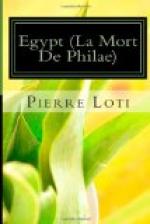*****
“He who instructs the ignorant is like a living man amongst the dead.”
“If a day passes without my having learnt something which brings me nearer to God, let not the dawn of that day be blessed.”
Verses from the Hadith.
He who has brought me to this place to-day is my friend, Mustapha Kamel Pacha, the tribune of Egypt, and I owe to his presence the fact that I am not treated like a casual visitor. Our names are taken at once to the great master of El-Azhar, a high personage in Islam, whose pupil Mustapha formerly was, and who no doubt will receive us in person.
It is in a hall very Arab in its character, furnished only with divans, that the great master welcomes us, with the simplicity of an ascetic and the elegant manners of a prelate. His look, and indeed his whole face, tell how onerous is the sacred office which he exercises: to preside, namely, at the instruction of these thousands of young priests, who afterwards are to carry faith and peace and immobility to more than three hundred millions of men.
And in a few moments Mustapha and he are busy discussing—as if it were a matter of actual interest—a controversial question concerning the events which followed the death of the Prophet, and the part played by Ali. . . . In that moment how my good friend Mustapha, whom I had seen so French in France, appeared all at once a Moslem to the bottom of his soul! The same thing is true indeed of the greater number of these Orientals, who, if we meet them in our own country, seem to be quite parisianised; their modernity is only on the surface: in their inmost souls Islam remains intact. And it is not difficult to understand, perhaps, how the spectacle of our troubles, our despairs, our miseries, in these new ways in which our lot is cast, should make them reflect and turn again to the tranquil dream of their ancestors. . . .




